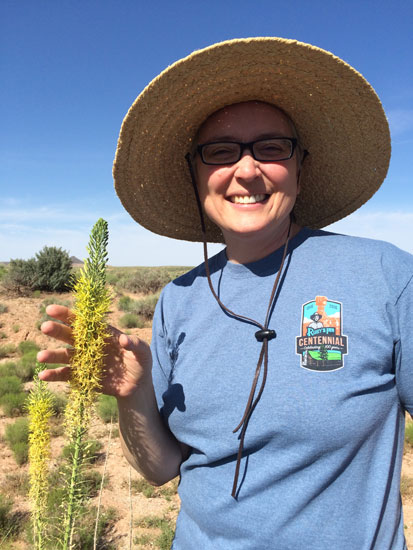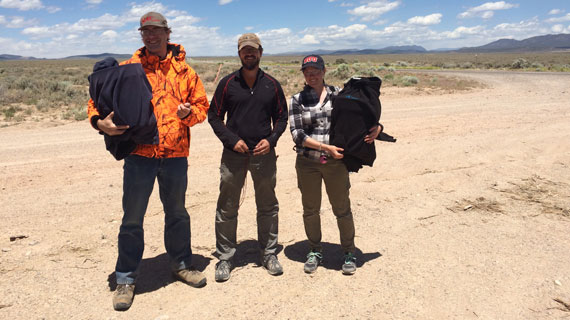Biology Professors Work with BLM to Fight Wildfires with Wildflowers
Published: June 27, 2017 | Author: Lexi Carter | Read Time: 4 minutes
 Dr. Jackie Grant, a biology professor at Southern Utah University, was recently awarded $67,949 from the Bureau of Land Management’s Colorado Plateau Native Plant Program (CPNPP) to collect seeds from native plants for research and restoration. These seeds are used to restore plant life after wildfires destroy forests and seeds in the underlying soil.
Dr. Jackie Grant, a biology professor at Southern Utah University, was recently awarded $67,949 from the Bureau of Land Management’s Colorado Plateau Native Plant Program (CPNPP) to collect seeds from native plants for research and restoration. These seeds are used to restore plant life after wildfires destroy forests and seeds in the underlying soil.
The project couldn’t have come at a better time. With the Brian Head Fire raging only 32 miles away from the University, Grant’s project will simultaneously train students on proper seed collection to treat the damaged land and help accelerate plant regrowth after the fire.
As of June 26, the Brian Head Fire has burned over 43,440 acres of land, destroyed 13 homes and 8 outbuildings and displaced more than 1,500 people. It will take 60 to 100 years for the forest to regrow, but thanks to Grant’s seed collection project, she can prevent non-native plants from slowing the process of reforestation. Native plants are crucial to maintain pollinator populations and feed wildlife such as elk and mule deer. However, fires the size of the Brian Head Fire sterilize the soil and kill most of the seeds.
“Native plants are important in Utah because this state is part of a fire-adapted ecosystem, which means that fires happen on a regular basis here,” said Grant. “We need plants to return to the land as soon as possible after a fire to prevent heavy rains from eroding the soil and filling streams with sediment that kills fish. Although we often overlook them, native plants provide the groundwork for what makes this state special.”
An associate professor of biology, director of the Garth and Jerri Frehner Museum of Natural History, and a conservation biologist, Grant focuses her teaching and personal research on green infrastructure and organismal biology.
Grant’s project highlights the importance of public lands in Utah. “We need an incredible number of seeds to restore plant communities after a fire of this size,” said Grant. “We get most of our seeds from public land where native plant populations are somewhat protected. However, private landowners can also play a role in wildfire restoration by granting permission for us to collect seeds on their land.”
Dr. Grant’s team has already started collecting the thousands of seeds needed to contribute to the restoration of native plant communities. This funding will also feed into other projects, including development of native plant and pollinator gardens at Iron County schools and determining which native plants can be used to improve green building infrastructure for water conservation in southern Utah.
 Grant and her colleague Dr. Matt Ogburn, assistant professor of biology, have hired two SUU students to travel across southern Utah and identify native plants as directed by the Colorado Plateau Native Plant Program of the BLM. Grant’s team will contribute to research performed by Magda Garbowski at Colorado State University, where scientists are trying to determine how to keep damaging non-native plants out of our ecosystems.
Grant and her colleague Dr. Matt Ogburn, assistant professor of biology, have hired two SUU students to travel across southern Utah and identify native plants as directed by the Colorado Plateau Native Plant Program of the BLM. Grant’s team will contribute to research performed by Magda Garbowski at Colorado State University, where scientists are trying to determine how to keep damaging non-native plants out of our ecosystems.
The team also plans to collect genetic tissue samples to send to their partner Rob Massatti and the United States Geological Survey in Flagstaff, Arizona. USGS researchers are using genetics to make seed collection and distribution more efficient and effective. Grant and Ogburn are also collaborating with the US Forest Service to find seeds from plants that improve sage grouse habitat, and plants that provide nectar for butterflies.
The research conducted this summer builds on previous work Grant has done with iUTAH, the state’s National Science Foundation EPSCoR grant. Benefits extend to more than SUU students because water, outdoor recreation, hunting, fishing, and access to the state’s incredible scenery are important to most residents of Utah.
Grant’s collaborations with iUTAH, a statewide research infrastructure improvement grant aimed at water research, education, and outreach, have been recognized with both a Research Catalyst Grant and an Education and Outreach Catalyst grant. A third award for time-release gave Dr. Grant the time to write the proposal for seed collection.
"Dr. Grant exemplifies what it means to be an 'engaged scholar,’ said Andy Leidolf, assistant director of iUTAH. “She embodies the objectives of iUTAH's research catalyst grant program and one of our project's core missions: to build capacity at primarily undergraduate institutions.”
“We are now able to weave science, education and our research through multiple levels of the community while providing experiential learning opportunities to SUU students and recent graduates,” said Grant. “The BLM grant is a fantastic opportunity for the university as it allows us to work with a federal program to provide economic and educational opportunities for the local community of Cedar City.”
Other funding obtained by Dr. Grant has come through the Utah Division of Arts and Museums and the Society for the Study of Evolution. Grant is currently developing a proposal with the Paiute Indian Tribe of Utah to create a trio of gardens devoted to native and culturally important plants.
Grant recently finished a DNA Barcoding course through the University of Guelph and is the current Vice President for Education Outreach for the Society for Conservation Biology where she serves on the board of governors and organizes educational activities at their international meetings. Locally, she contributes to Cedar City as a member of the Trails Commission, a partner with K-12 science teachers, and a board member of the Southwest Wildlife Foundation.
To learn more about Grant’s research or to volunteer for seed collection, contact Dr. Jackie Grant at jacqualinegrant@suu.edu. For updates on the Brian Head Fire, follow the hashtag #BrianHeadFire on Twitter.Contact Information:
435-586-5400
Contact the Office of Marketing Communication
This article was published more than 3 years ago and might contain outdated information or broken links. As a result, its accuracy cannot be guaranteed.

